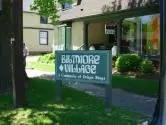Just How Many Biltmore’s Are There?

My column last week prompted a reader who is coming to the Grove Park Inn Arts and Crafts Conference next month to ask, “Just how many Biltmore’s are there in Asheville?”
Provided you don’t count the Biltmore Barber Shop, the Biltmore Baptist Church, the Biltmore Lamp Shade Gallery, the Biltmore Dental Group, Biltmore Iron and Metal, and Biltmore Ob-Gyn, there are three: the Biltmore Estate, Biltmore Village, and Biltmore Industries.
Biltmore Estate – It all started in 1890 just outside Asheville when young George Vanderbilt, aided by senior architect Richard Morris Hunt and landscape architect Frederick Law Olmsted, began construction on his 250-room French chateau situated on a bluff overlooking his 146,000-acre estate. The house was completed in 1895, but George Vanderbilt died unexpectedly in 1914; it served as his family’s private residence until his widow Edith Vanderbilt open it for paid tours during the Great Depression. Today the house and estate attract nearly one million visitors a year, and is still owned by one of Vanderbilt’s grandsons. The house, grounds, restaurants, greenhouse, gardens, winery, and shops deserve nearly a full day in order to appreciate them fully. For more information, go to www.Biltmore.com.

Biltmore Village – It takes a village to run a 146,000-acre estate, so in the 1890s George Vanderbilt created one for his workers and their families just outside the main entrance. The original homes were designed by English Arts and Crafts architect Richard Sharpe Smith, who stayed to become Asheville’s most prolific 20th century architect. They have since been converted into cafes, galleries, and shops. The tree-lined streets, their brick sidewalks, and the quaint architecture make this intimate shopping experience popular with both local residents and tourists.
Biltmore Industries – In 1905 Edith and George Vanderbilt financed an Arts and Crafts cottage business first called Biltmore Estate Industries. The young men and women (children of estate workers) made hand-carved bowls, bookends, picture frames, and trays, along with some furniture, all of which are highly collectible today. In 1917, Frederick L. Seely, general manager of the Grove Park Inn, purchased the cottage business from the widowed Edith Vanderbilt. He then constructed five Arts and Crafts workshops and weaving rooms on a shaded hillside adjacent to the hotel, renaming it Biltmore Industries. We offer free walking tours each day of the National Arts and Crafts Conference. (www.Arts-CraftsConference.com)
And today all three of these Biltmores are thriving.
My personal favorite, quite naturally, is Biltmore Industries, for it has survived since 1905, enduring troubled times that counted among its victims Gustav Stickley, the Roycrofters, Grueby Pottery, Stickley Brothers, Charles Limbert, and scores of other Arts and Crafts enterprises. I only wish more guests at the Grove Park Inn made the five-minute walk across the quiet roadway to Biltmore Industries, for awaiting there is an historic enclave that now includes a quaint café, the nationally-ranked Grovewood Gallery, several artisans shops, a museum with Roycroft furniture and Biltmore Industries carvings, and an astonishing automobile museum in what had once been the loom building.
Pretty amazing, even for Asheville, which continues to be the most amazing city I have ever lived in.

Until next Monday,
Find your most amazing place – or come share mine!
Bruce
To see the brochure for next month’s conference, click on:
http://www.arts-craftsconference.com/images/Brochure.2015.pdf
